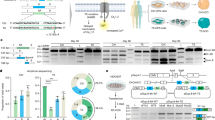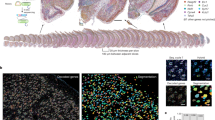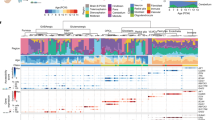Abstract
The differentiation of pluripotent stem cells in three-dimensional cultures can recapitulate key aspects of brain development, but protocols are prone to variable results. Here we differentiated multiple human pluripotent stem cell lines for over 100 d using our previously developed approach to generate brain-region-specific organoids called cortical spheroids and, using several assays, found that spheroid generation was highly reliable and consistent. We anticipate the use of this approach for large-scale differentiation experiments and disease modeling.
This is a preview of subscription content, access via your institution
Access options
Access Nature and 54 other Nature Portfolio journals
Get Nature+, our best-value online-access subscription
$29.99 / 30 days
cancel any time
Subscribe to this journal
Receive 12 print issues and online access
$259.00 per year
only $21.58 per issue
Buy this article
- Purchase on Springer Link
- Instant access to full article PDF
Prices may be subject to local taxes which are calculated during checkout


Similar content being viewed by others
References
Di Lullo, E. & Kriegstein, A. R. Nat. Rev. Neurosci. 18, 573–584 (2017).
Pașca, S. P. Nature 553, 437–445 (2018).
Kelava, I. & Lancaster, M. A. Cell Stem Cell 18, 736–748 (2016).
Bershteyn, M. et al. Cell Stem Cell 20, 435–449 (2017).
Mariani, J. et al. Cell 162, 375–390 (2015).
Lancaster, M. A. et al. Nature 501, 373–379 (2013).
Sloan, S. A. et al. Neuron 95, 779–790 (2017).
Qian, X. et al. Cell 165, 1238–1254 (2016).
Blair, J. D., Hockemeyer, D. & Bateup, H. S. Nat. Med. 24, 1568–1578 (2018).
Paşca, A. M. et al. Nat. Methods 12, 671–678 (2015).
Sloan, S. A., Andersen, J., Pașca, A. M., Birey, F. & Pașca, S. P. Nat. Protoc. 13, 2062–2085 (2018).
Birey, F. et al. Nature 545, 54–59 (2017).
Stein, J. L. et al. Neuron 83, 69–86 (2014).
BrainSpan. BrainSpan: Atlas of the Developing Human Brain http://www.brainspan.org (2013).
Fan, H. C., Fu, G. K. & Fodor, S. P. Science 347, 1258367 (2015).
Quadrato, G. et al. Nature 545, 48–53 (2017).
Camp, J. G. et al. Proc. Natl Acad. Sci. USA 112, 15672–15677 (2015).
Pașca, S. P. et al. Nat. Med. 17, 1657–1662 (2011).
Gallego Romero, I. et al. eLife 4, e07103 (2015).
Yoon, S. J. & Pașca, S. P. Protoc. Exch. https://doi.org/10.1038/protex.2018.123 (2018).
Dobin, A. et al. Bioinformatics 29, 15–21 (2013).
Li, B. & Dewey, C. N. BMC Bioinformatics 12, 323 (2011).
Oldham, M. C., Langfelder, P. & Horvath, S. BMC Syst. Biol. 6, 63 (2012).
Johnson, W. E., Li, C. & Rabinovic, A. Biostatistics 8, 118–127 (2007).
McKenna, A. et al. Genome Res. 20, 1297–1303 (2010).
Purcell, S. et al. Am. J. Hum. Genet. 81, 559–575 (2007).
Liao, Y., Smyth, G. K. & Shi, W. Bioinformatics 30, 923–930 (2014).
Robinson, M. D., McCarthy, D. J. & Smyth, G. K. Bioinformatics 26, 139–140 (2010).
Ritchie, M. E. et al. Nucleic Acids Res. 43, e47 (2015).
Acknowledgements
We acknowledge support from J. Dreux and J. Lai (at BD Genomics) for running the pipeline and Data View troubleshooting. This work was supported by the US National Institutes of Health (NIH) BRAINS Award (MH107800), the MQ Fellow Award, the NYSCF Robertson Stem Cell Investigator Award, the Donald E. and Delia B. Baxter Foundation Award, the Stanford Neurosciences Institute’s Brain Rejuvenation Project, the Kwan Research Fund, a NARSAD Independent Investigator Award from the Brain & Behaviour Research Foundation (BBRF), and Stanford Start-up Funds (to S.P.P.); the California Institute of Regenerative Medicine (CIRM) and NIH U01 (MH115745) (to D.H.G. and S.P.P.); CIRM Bridges Program (to L.S.E.); a Stanford School of Medicine Dean’s Postdoctoral Fellowship (to Y.M.); a National Science Foundation (NSF) Graduate Research Fellowship (to R.M.M.); NIH K12-HD000850 (Pediatric Scientist Development Program) and a Stanford Child Health Research Institute Fellowship (to A.M.P); and the Autism Science Foundation Fellowship (to A.G.).
Author information
Authors and Affiliations
Contributions
S.J.Y., R.M.M. and S.P.P. developed the differentiation method. S.J.Y. and L.S.E. performed differentiation experiments. S.J.Y., L.S.E., A.M.P., R.M.M. and Y.M. characterized the protocol. E.M.W., G.M.H. and H.C.F. performed the single-cell transcriptomics experiments and analysis. A.G. and D.H.G. performed the RNA-seq and analysis. O.R., S.P.P. and J.R.H. designed, conducted or analyzed the electrophysiological experiments. S.J.Y. and S.P.P. wrote the manuscript with input from all other authors. S.P.P. supervised the work.
Corresponding author
Ethics declarations
Competing interests
Stanford University has filed a provisional patent application that covers the generation of region-specific neural spheroids (US Application Serial No. 15/158,408). H.C.F., E.M.W. and G.M.H. were employees of BD Genomics during this study.
Additional information
Publisher’s note: Springer Nature remains neutral with regard to jurisdictional claims in published maps and institutional affiliations.
Integrated supplementary information
Supplementary Figure 1
(a) Example images of hiPSC maintained in feeder-free conditions, aggregates of dissociated hiPSCs in AggreWell microwells shown the day before starting neural differentiation, at 24 h after aggregation, after dislodging and at day 10 in vitro. (b–d) Gene expression (relative to GAPDH) at day 25 of differentiation for (b) the ectoderm marker SOX2, the mesoderm marker BRACH, the endoderm marker SOX17, and (c) the forebrain marker SIX3, and (d) midbrain (FOXA2), hypothalamus (RAX), striatal (GSX2) or spinal cord (HOXB4), markers; n = 12 hiPSC lines from 11 subjects in hCS-FF except for RAX, HOXB4 where n = 8 hiPSC lines, and BRACH and SOX17 where n = 6 hiPSC lines. Mean ± s.e.m. are shown.
Supplementary Figure 2
(a) Example cryosection of a hCS-FF at day 75 stained for PAX6 (dorsal forebrain progenitors, magenta) and TBR2 (intermediate progenitor cells, green) showing the presence of a VZ-like region organized around a lumen and an SVZ-like region beyond the VZ. (b) Example cryosection of hCS-FF at day 73 of differentiation showing expression of the progenitor marker SOX2 and the outer radial glia marker HOPX. (c) Example cryosection of hCS-FF at day 73 of differentiation showing expression of RELN and TBR1. (d) Example cryosection of hCS-FF at day 130 of differentiation showing expression of deep layer marker TLE4 and the upper layer marker BRN2. (e) Example cryosections of hCS-FF derived from an α-tubulin-mEGFP hiPSC line showing expression of cleaved Caspase 3 (c-Cas3) and overall morphology of hCS-FF at various stages of differentiation in vitro.
Supplementary Figure 3
Rank–rank hypergeometric overlap (RRHO) between hCS-FF (a) and hCS-MEF (b) of day 100 of differentiation compared to day 25 versus all pairwise comparison of stages from developing human cerebral cortex (BrainSpan). #2 indicates the 4–8 PCW stage, #6 indicates the 19–24 PCW stage, while #8 indicated postnatal stages. Genes were sorted by log fold-change. Axes of individual plots are the rankings of the genes (x-axis: hCS data, y-axis: BrainSpan data). Higher overlap led to smaller P values (higher –log10(P values)) which are represented by redder areas. Bottom left and top right of each plot are the overlap of down- and upregulated genes in both datasets, respectively. One-sided rank–rank hypergeometric test; for day 25, n = 22 hCS-FF samples and n = 3 hCS-MEF samples; for day 100, n = 22 hCS-FF samples and n = 4 hCS-MEF samples.
Supplementary Figure 4
(a) Distribution of expression of the neuronal marker STMN2, the progenitor marker VIM, and of a set of genes, which are associated with the M cell cycle phase (n = 24,237 cells). (b) Correlation (log10 transformed mean of molecules per cell per gene) between hCS-MEF and each of the hCS-FF cultures or the hSS-MEF.
Supplementary Figure 5
Trajectories of selected marker genes during hCS-FF differentiation: neural progenitors related genes (SOX2, PAX6, FOXG1), general neuronal and glial markers (SLC17A7 also known as VGLUT1, MAP2, NCAM1, AQP4), deep layer-specific cortical genes (TBR1, CTIP2 also known as BLC11B, ETV1, RORB SOX5,), and upper layer cortical genes (SATB2, CUX2, TLE1). Trend lines are averages of all data points. Color and shape denote the protocol used to grow cortical spheroids: FF (red circles) or MEF (black triangles).
Supplementary Figure 6
(a) Whole cell current clamp slice recording from an AAV (DJ)-Syn1::mCherry+ neuron showing repetitive action potential firing in response to a depolarizing current injection (day 85–130; n = 13 neurons). (b) Single action potential waveform aligned to its first derivative. (c) Membrane responses after a 30 pA depolarizing current injection before and during application of the sodium channel blocker TTX (n = 3 neurons). (d) Voltage clamp recording at –70 mV showing spontaneous EPSCs, which are blocked by the glutamate receptor antagonists NBQX (20 μM) and APV (100 μM) (n = 13 neurons). (e) Quantification of the spontaneous EPSC rate before and during application of NBQX (20 μM) and APV (100 μM) in slices of hCS-FF at days 120–130 of differentiation (n = 13 cells; two-sided paired t-test ***P = 0.0004). (f) Example of a digitally reconstructed hCS-FF neuron infected with an AAV (DJ)-Syn1::ChR2-mCherry (in dissociated cultures). (g) Current clamp recording from the neuron shown in (f) showing action potential generation in response to a 2 ms blue light pulse delivered via fiber optic. (h) Membrane potential response to 5 ms-long blue light pulses delivered at increasing rates (8–32 Hz) showing frequency-dependent AP failures (n = 7 neurons). (i) Quantification of action potential success rate in AAV (DJ)-Syn1::ChR2-mCherry+ cells following blue light pulses delivered at increasing rates (8–32 Hz); shading indicates s.e.m.
Supplementary information
Supplementary Text and Figures
Supplementary Figs. 1–6 and Supplementary Tables 1, 2, and 4
Supplementary Table 3
Samples used for RNA-seq
Rights and permissions
About this article
Cite this article
Yoon, SJ., Elahi, L.S., Pașca, A.M. et al. Reliability of human cortical organoid generation. Nat Methods 16, 75–78 (2019). https://doi.org/10.1038/s41592-018-0255-0
Received:
Accepted:
Published:
Issue Date:
DOI: https://doi.org/10.1038/s41592-018-0255-0
This article is cited by
-
Parechovirus infection in human brain organoids: host innate inflammatory response and not neuro-infectivity correlates to neurologic disease
Nature Communications (2024)
-
Kirigami electronics for long-term electrophysiological recording of human neural organoids and assembloids
Nature Biotechnology (2024)
-
Functional brain region-specific neural spheroids for modeling neurological diseases and therapeutics screening
Communications Biology (2023)
-
Schizophrenia-associated NRXN1 deletions induce developmental-timing- and cell-type-specific vulnerabilities in human brain organoids
Nature Communications (2023)
-
Joint epigenome profiling reveals cell-type-specific gene regulatory programmes in human cortical organoids
Nature Cell Biology (2023)



